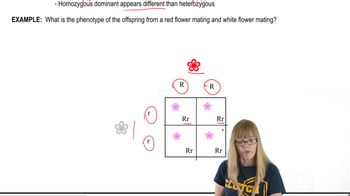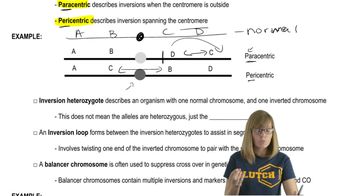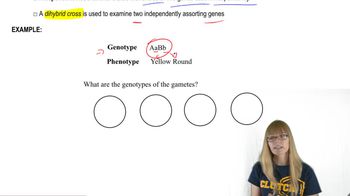Table of contents
- 1. Introduction to Genetics51m
- 2. Mendel's Laws of Inheritance3h 37m
- 3. Extensions to Mendelian Inheritance2h 41m
- 4. Genetic Mapping and Linkage2h 28m
- 5. Genetics of Bacteria and Viruses1h 21m
- 6. Chromosomal Variation1h 48m
- 7. DNA and Chromosome Structure56m
- 8. DNA Replication1h 10m
- 9. Mitosis and Meiosis1h 34m
- 10. Transcription1h 0m
- 11. Translation58m
- 12. Gene Regulation in Prokaryotes1h 19m
- 13. Gene Regulation in Eukaryotes44m
- 14. Genetic Control of Development44m
- 15. Genomes and Genomics1h 50m
- 16. Transposable Elements47m
- 17. Mutation, Repair, and Recombination1h 6m
- 18. Molecular Genetic Tools19m
- 19. Cancer Genetics29m
- 20. Quantitative Genetics1h 26m
- 21. Population Genetics50m
- 22. Evolutionary Genetics29m
3. Extensions to Mendelian Inheritance
Understanding Independent Assortment
Problem 31
Textbook Question
Textbook QuestionA woman expressing a dominant phenotype is heterozygous (Dd) for the gene.
What is the probability that the dominant allele carried by the woman will be inherited by a grandchild?
 Verified Solution
Verified SolutionThis video solution was recommended by our tutors as helpful for the problem above
Video duration:
3mPlay a video:
Was this helpful?
Key Concepts
Here are the essential concepts you must grasp in order to answer the question correctly.
Dominant and Recessive Alleles
In genetics, alleles are different forms of a gene. A dominant allele, represented by a capital letter (e.g., D), masks the effect of a recessive allele (e.g., d) when both are present. This means that an individual with at least one dominant allele will express the dominant phenotype. Understanding this concept is crucial for predicting inheritance patterns.
Recommended video:
Guided course

Variations on Dominance
Heterozygosity
Heterozygosity refers to having two different alleles for a particular gene, such as Dd. In this case, the individual carries one dominant allele and one recessive allele. This genetic makeup influences the probability of passing on alleles to offspring, as the heterozygous individual can contribute either allele to the next generation.
Recommended video:
Guided course

Inversions
Punnett Square
A Punnett square is a diagram used to predict the genetic makeup of offspring from a particular cross. It allows for the visualization of how alleles from each parent combine. In this scenario, understanding how to set up a Punnett square with the woman's genotype (Dd) and her partner's genotype will help determine the probability of the grandchild inheriting the dominant allele.
Recommended video:
Guided course

Chi Square Analysis

 4:58m
4:58mWatch next
Master Gamete Genetics and Independent Assortment with a bite sized video explanation from Kylia Goodner
Start learningRelated Videos
Related Practice


